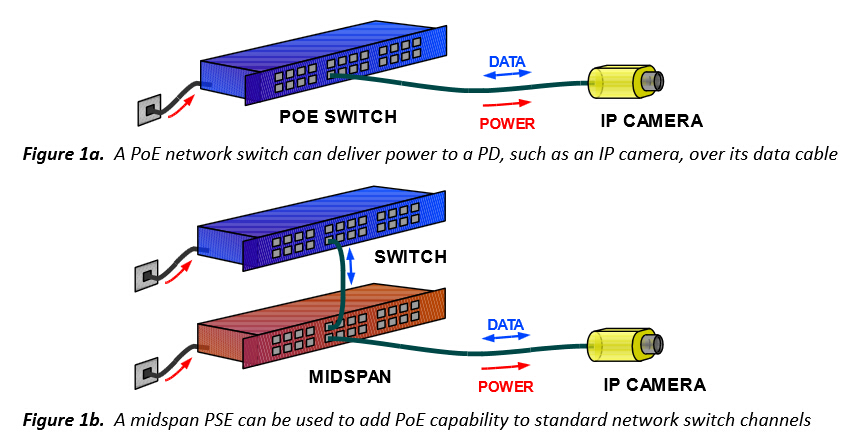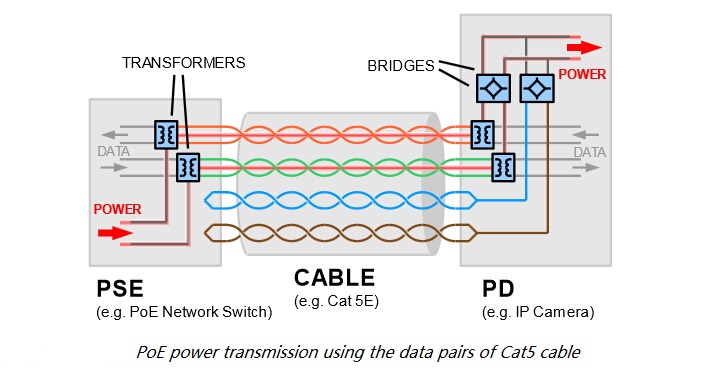With the introduction of new Ethernet-enabled devices expanding geometrically, the need to power these devices from standard AC power outlets has become a limiting factor. IP phones, wireless access points, IP cameras and device servers are examples of devices limited by the need to have an AC power outlet nearby to plug in a DC power adaptor. At best, power supply installation and wiring add labour and result in the mess of extra wiring; worst case, the lack of nearby AC power means devices cannot be installed where they are needed.
In response to this need, IEEE developed IEEE802.3af to standardise a system of supplying low-voltage power to networked devices via the communications line. It is more commonly referred to as Power over Ethernet (POE). This article focuses on introducing some fundamental elements of PoE.
PoE is defined across a single network link that includes three basic components. The first one is equipment delivering power to the cable (often referred to as a PSE, which stands for power sourcing equipment). The second component is a device receiving power from the cable (also known as a powered device, or PD). The third is the cable itself.
Typical PDs include IP cameras and wireless access points, and the PSE would normally be a PoE switch or a midspan power injector, patched in to add PoE capability to a non-PoE network switch channel or similar. These two configurations are shown in the following picture.

The most prominent advantages of PoE are time-saving and cost-effective. By reducing the time and expense of having electrical power cabling installed, network cables do not require a qualified electrician to fit them, thus they can be located anywhere. Besides, it has great flexibility. Without being tethered to an electrical outlet, the PDs (IP cameras, wireless access points) could be located wherever they are needed most. Safety is the third advantage. PoE delivery is intelligent and it is designed to protect network equipment from overload, or incorrect installation. Also, it has reliability and scalability. PoE power comes from a central and universally compatible source, rather than a collection of distributed wall adapters. It can be backed up by an uninterruptible power supply, or controlled to easily disable or reset devices.
The original PoE application is VoIP phones, which have a single connection to a wall socket and can be remotely powered down, just like with the older analogue systems. PoE could also be used in IP cameras. It is ubiquitous on networked surveillance cameras where it enables fast deployment and easy repositioning. Wifi and Bluetooth APs and RFID (radio frequency identification devices) readers are commonly PoE-compatible, to allow remote locations away from AC outlets, and relocation following site surveys.
PoE is designed to operate over standard network cable: Cat 5e, Cat 6, Cat 6a or Cat 7 (often collectively referred to as Cat 5e), using conventional RJ45 connectors. The principles of carrying electrical power over Cat5e are of no difference to those of other power distribution systems, but as the power is being transferred over light-duty cable for long distances, the effects of the power loss and voltage drop become significant.
The arrangement and connection to the cabling used for PoE also differ slightly from conventional power wiring, to work around the existing standard for Ethernet data. Cat 5e network cables contain a bundle of eight wires, arranged as four twisted pairs shown in the following picture. In the most common type of Ethernet, 100BASE-T or Fast Ethernet, only two of the four pairs are used to carry data; each pair carrying a signal in one direction. These are known as the data pairs, and the remaining two are unused and are referred to as the spare pairs.

Although each data signal can be carried within a single pair, PoE treats each pair of wires as a single conductor (a reason for this is that using both wires halves the overall resistance). As electrical current must flow in a loop, two pairs are required to allow power to be carried by the cable, and either the data or spare pairs can be used for this. The PD must be able to accept power from whichever pairs the PSE delivers it to.
PoE is a convenient and now ubiquitous method for delivering power to a wide variety of loads on standard Cat 5e Ethernet cables. There is no doubt that Power over Ethernet will become increasingly important shortly.
